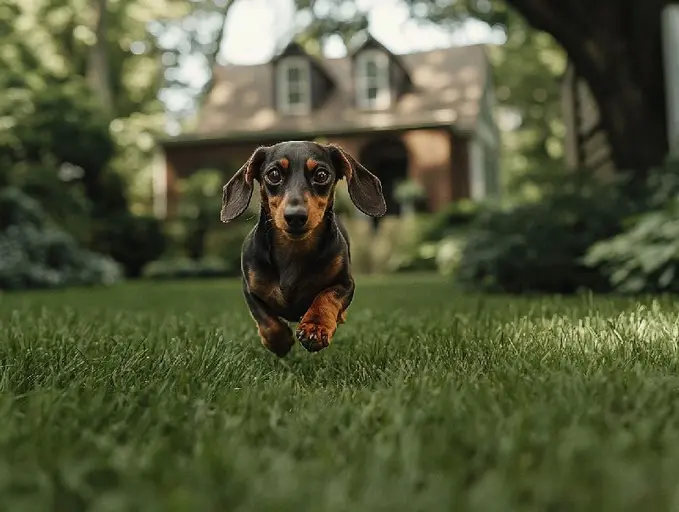Thinking About a Dachshund? A Tail-Wagging Guide to This Unique Breed

Brief Introduction
The Dachshund, affectionately nicknamed the “Weiner Dog” or “Sausage Dog,” is a breed instantly recognizable by its long body and short legs. Originating in Germany, these low-riding dogs were originally bred for hunting badgers, which explains their fearless and determined nature. Dachshunds come in three coat varieties: smooth, wirehaired, and longhaired, expanding their appeal to a wide range of potential owners. Their playful personalities and unique appearance make them a popular choice for families and individuals alike. But before you bring a Dachshund home, it’s important to understand their specific needs and characteristics to ensure a happy and healthy life together.
Breed History
Origins and Purpose
The Dachshund’s history dates back to the 15th century in Germany, although dogs resembling modern Dachshunds appear in artwork from earlier centuries. These early Dachshunds were bred specifically for hunting burrowing animals, primarily badgers (“Dachs” in German). Their short legs and elongated bodies allowed them to easily enter and navigate badger dens. They were also used to hunt other small animals like rabbits and foxes. These German badger dogs were highly valued by hunters for their bravery, persistence, and keen sense of smell.
Development and Standardization
Over time, breeders refined the Dachshund breed to create different sizes and coat types. The standard Dachshund was developed for hunting larger prey, while the miniature Dachshund was bred to hunt smaller animals. The different coat varieties – smooth, wirehaired, and longhaired – were achieved through crosses with various other breeds, such as terriers and spaniels. The breed standard was officially established in the late 19th century, further solidifying the Dachshund’s unique characteristics.
Modern Dachshunds
Today, the Dachshund is primarily a companion animal, although their hunting instincts remain strong. They continue to be beloved for their unique appearance, playful personalities, and unwavering loyalty. While they may not be chasing badgers down burrows, they still enjoy exploring, digging, and using their powerful noses.
Appearance
Size and Weight
Dachshunds come in two sizes: standard and miniature. Here’s a quick look at their typical measurements:
- Standard Dachshund: Weighs between 16 and 32 pounds and stands 8 to 9 inches tall at the shoulder.
- Miniature Dachshund: Weighs 11 pounds or less and stands 5 to 6 inches tall at the shoulder.
Coat Varieties and Colors
Dachshunds boast three distinct coat types:
- Smooth-haired: Short, shiny, and smooth coat.
- Wire-haired: A rough, wiry outer coat with a soft undercoat. They often have a beard and eyebrows.
- Long-haired: A silky, flowing coat that is slightly wavy.
Their colors are highly variable, and can be:
- Solid colors: Red, cream, black, chocolate, and fawn.
- Patterns: Dapple (merle), brindle, sable, and piebald.
- Color combinations: Black and tan, chocolate and tan, etc.
Other Distinctive Features
Beyond their signature long body, Dachshunds have other notable features:
- Ears: Long, floppy, and set low on the head.
- Eyes: Almond-shaped and dark, with an intelligent and expressive gaze.
- Tail: Set as a continuation of the spine, carried high.

Character and Behavior
Temperament and Personality
Dachshunds are known for their playful, intelligent, and courageous personalities. They can be very independent and stubborn, which can sometimes make training a challenge. However, with patience and consistency, they can learn to be well-behaved companions. They are also known for being quite brave, a trait stemming from their hunting heritage.
Attitude Towards People and Children
Dachshunds are generally affectionate with their families, but they can be wary of strangers. Early socialization is important to create friendly behavior. They can be good with children, but supervision is always necessary, especially with younger children. Dachshunds can be sensitive to rough handling and may snap if they feel threatened. Teaching children how to interact respectfully with dogs is crucial for a positive relationship.
Interaction with Other Animals
Dachshunds may be territorial and prone to chasing smaller animals, a reflection of their hunting instincts. Early socialization with other dogs and cats is important to minimize potential conflicts. Some Dachshunds can live harmoniously with other pets, while others may be better suited to being the only animal in the household. A slow and careful introduction when bringing a Dachshund into a multi-pet household is essential.
Activity Level and Trainability
Dachshunds have a moderate energy level. They enjoy walks, playtime, and exploring their surroundings. While they don’t require excessive amounts of exercise, regular physical activity is important to prevent weight gain and keep them mentally stimulated.
Trainability can be a challenge due to their independent nature. Positive reinforcement techniques, such as treats and praise, are most effective. Consistency and patience are key. They excel in activities like scent work and obedience training when motivated. Housetraining can sometimes be difficult, requiring consistent routines and supervision.
Breed Characteristics
Stubbornness, loyalty, and a strong prey drive are characteristic of the breed. They are known for their barking, which can be a nuisance if not managed. They are also diggers, so providing a designated digging area in the yard can redirect this behavior.
Care and Maintenance
Grooming Needs and exercise
Grooming requirements vary depending on the coat type:
- Smooth-haired: Requires minimal grooming. Occasional brushing to remove loose hair is sufficient.
- Wire-haired: Needs regular brushing to prevent matting. Hand stripping may be necessary to maintain the coat’s texture.
- Long-haired: Requires daily brushing to prevent tangles and mats. Regular trimming may also be needed.
Regarding exercise, daily walks are essential to maintain Dachshund’s activity level. They shouldn’t jump from high places, as their long backs are prone to injuries. Regular play sessions indoors or in a fenced yard are also beneficial.
Feeding and Diet
A well-balanced diet formulated for small breeds is essential. Portion control is vital to prevent weight gain, which can put additional strain on their backs. Avoid overfeeding and limit treats. Consult with your veterinarian to determine the appropriate amount of food based on your Dachshund’s age, activity level, and overall health.
Health Considerations and Possible Problems
Dachshunds are prone to certain health problems, including:
- Intervertebral Disc Disease (IVDD): This is a common spinal condition in Dachshunds due to their long backs, which makes them prone to slipped or ruptured discs. Keep your dog at a healthy weight levels and discourage jumping to minimize the risks.
- Progressive Retinal Atrophy (PRA): An eye disease that can lead to blindness.
- Obesity: Dachshunds are prone to weight gain, which exacerbates spinal problems.
- Bloat (Gastric Dilatation-Volvulus): While less common than in larger breeds, bloat can still occur in Dachshunds.
- Epilepsy: Some Dachshunds are genetically predisposed to epilepsy.
Regular veterinary checkups are essential for early detection and management of these potential problems.
Breed Weaknesses
Aggression and Socialization
While not inherently aggressive, Dachshunds can be territorial and protective, which can sometimes lead to aggression towards strangers or other animals if not properly socialized. Early socialization and consistent training are crucial for preventing aggressive behaviors.
Loyalty and Independence
Dachshunds form strong bonds with their families and are fiercely loyal. However, their independence can sometimes make them difficult to train. They may choose to ignore commands if they don’t see a reason to obey.
Specific Weaknesses
Their long backs make them susceptible to spinal problems, so preventing jumping and maintaining a healthy weight are critical. They are also prone to dental problems, which can be mitigated by a good dental care routine.
Conclusion
The Dachshund is a unique and charming breed with a lot to offer. They are playful, intelligent, and loyal companions. However, potential owners should be aware of their specific needs and potential health problems. This breed is suitable for:
- Individuals or families who are prepared to provide consistent training and socialization.
- Owners who are willing to manage their exercise and diet to prevent weight gain and spinal problems.
- Individuals who can provide a loving and supportive home where the Dachshund feels safe and secure.
If you are willing to put in the time and effort to understand and meet the needs of a Dachshund, you will be rewarded with a loyal and loving companion for many years to come.
Frequently Asked Questions About Dachshund
-
What is a Dachshund?
The Dachshund, also known as the “Weiner Dog” or “Sausage Dog,” is a breed from Germany characterized by its long body and short legs. They were originally bred for hunting badgers.
-
What are the different coat varieties of Dachshunds?
Dachshunds come in three coat varieties: smooth, wirehaired, and longhaired.
-
How big do Dachshunds get?
Dachshunds come in two sizes:
- Standard: Weighs 16-32 pounds and stands 8-9 inches tall.
- Miniature: Weighs 11 pounds or less and stands 5-6 inches tall.
-
What is the temperament of a Dachshund?
Dachshunds are known for their playful, intelligent, and courageous personalities. They can be independent and stubborn but are also loyal and affectionate with their families.
-
Are Dachshunds good with children?
Dachshunds can be good with children, but supervision is necessary, especially with younger children. They can be sensitive to rough handling.
-
How much exercise do Dachshunds need?
Dachshunds have a moderate energy level. They enjoy daily walks and playtime. Regular physical activity is important to prevent weight gain.
-
What are some common health problems in Dachshunds?
Dachshunds are prone to Intervertebral Disc Disease (IVDD), Progressive Retinal Atrophy (PRA), obesity, bloat, and epilepsy.
-
How do I care for a Dachshund’s coat?
Grooming depends on the coat type. Smooth-haired Dachshunds require minimal grooming. Wire-haired Dachshunds need regular brushing and hand stripping. Long-haired Dachshunds need daily brushing to prevent tangles.
-
Why is a healthy weight important for a Dachshund?
Maintaining a healthy weight is crucial for Dachshunds because they are prone to spinal problems like IVDD. Excess weight puts additional strain on their backs.
-
Are Dachshunds easy to train?
Trainability can be a challenge due to their independent nature. Positive reinforcement techniques are most effective. Consistency and patience are key.

